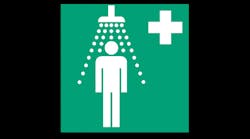Many articles have been written on what the ANSI Z358.1 standard tells us is the proper placement of emergency showers and eyewashes, but it equally is important to use common sense in making the decision to buy one of the many emergency shower and eyewash solutions available in the marketplace. Careful consideration can save you time and expense when trying to determine the right fit for your particular situation.
The size and scope of the emergency shower and eyewash solution needs to determined by the proximity of the hazard, the hazardous material itself and how many workers might be present in the area at a given time.
Take, for example, the proximity of the hazard. The ANSI standard says that the placement of a shower and eyewash unit needs to be within 10 seconds, or in close proximity of (55 feet according to the Z358.1 guidelines) the hazard. Logically consider the situation when determining where the unit should go. If a worker is injured, he might not be able to see clearly or at all. He might be panicking or in pain, which could slow him down or cause him to not react in a rational manner.
In addition, having emergency equipment too close to a hazard possibly can cause contamination to the unit during its operation.
To comply with the ANSI standard, you must ensure that no obstruction exists in or near the pathway of the emergency equipment. High visibility signage also is necessary to draw attention to the location of the equipment.
When surveying each hazardous location for the proper placement, these and other questions must be closely scrutinized to determine specific needs based on the ANSI standard and good common sense.
Hazard Analysis
The hazardous materials present in the workplace play a significant role in determining what the right emergency shower and eyewash solution might be. If the greatest possibility of exposure is to the eye or face, a plumbed eyewash or one of the portables (pressurized, gravity fed or a sealed cartridge) might be the best solution. However, if corrosives are present, you may need a more comprehensive solution like a plumbed combination shower and eyewash unit.
Having the ability to utilize a drenching accessory also may be important should only an eye/face wash solution be deemed necessary. However, the drench operation cannot deplete the fluid necessary to wash the eyes (or face) for a period of 15 minutes. Drench hoses alone are not a substitute for an eyewash or shower.
A thorough hazard analysis that considers the chemical properties that exist should be performed to facilitate the correct choice of shower or eyewash equipment. Knowing the effect of the chemical on the nervous system or the possibility of the worker becoming debilitated or incoherent also can aid in making the best choice. Safety professionals should consider the inclusion of shower and eyewash equipment where packaged chemical s ar e present in a warehouse setting. If there is any possibility of a release of a hazardous substance as a result of lifting equipment penetrating the packaging, you strongly need to consider protecting the worker by choosing the appropriate emergency equipment based on the MSDS contents.
Number of Workers Impacted
The number of employees who are present in a work area also impacts the selection and location of showers and eyewashes. More than one emergency shower and eyewash may be necessary if there are many workers near a hazardous substance. If there is an emergency release of corrosive in an area populated by more than one person, it may make sense to install multiple units.
Following the ANSI Z358.1 standard is a great place to star t. Copies of the standard can be purchased through the International Safety Equipment Association. You also can tap into the vast knowledge available through the emergency shower and eyewash equipment manufacturers, many of whom serve on the Z358.1 committee and recommend improvements to the ANSI standard. Many innovations continue to be made to shower and eyewash equipment to provide adequate solutions for many specific hazards.
When choosing emergency eyewash and shower equipment for the worksite, regardless of the hazards or location, it is extremely important to use common sense and thorough analysis to determine the correct solution based on all the factors that exist in each work environment. One solution certainly does not fit every situation.
Michael Bolden is director of marketing and sales for Encon Safety Products Inc. (http://www.enconsafety.com).
